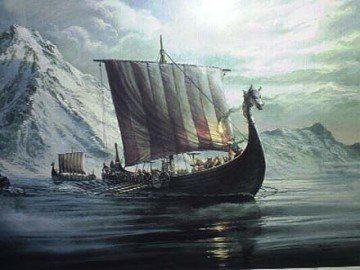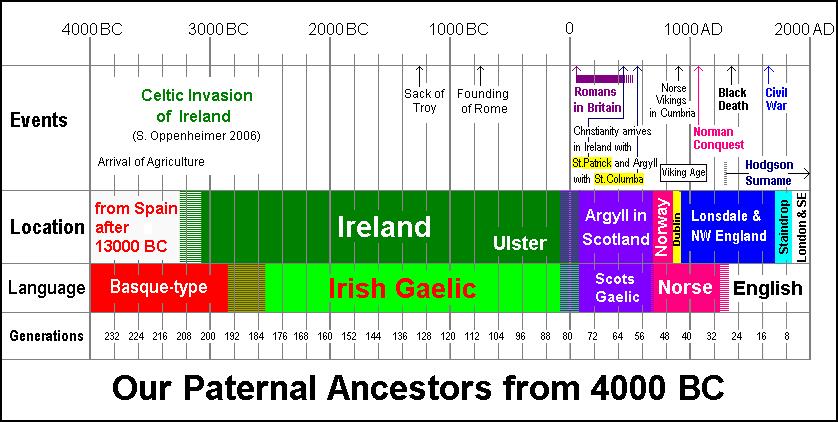The Hodgson Clan
Where all things Hodgson come together...
An Example of Insights from Hodgson DNA Analysis
Geoffrey M. Hodgson, member of Hodgson Group 6.3, details his analysis of his paternal Y-DNA

Deep Ancestry
As an illustration of what is possible with DNA analysis, Geoffrey M. Hodgson explains below what has been achieved with a 37-marker test on his father's Y-DNA:
Hodgson Y-DNA is diverse and has so far been classified into 12 Hodgson Groups. The Y-DNA of my father and myself is in the commonplace haplogroup R1b. About 55 per cent of Hodgsons are in this same haplogroup. Members of haplogroup R1b are believed to have come to Britain and Ireland after the glacial ice sheet retreated about 15,000 years ago, from enclaves in Northern Spain and Southern France (Sykes 2006, Oppenheimer 2006). They are now most common in places such as Ireland and the Basque Country.
The large R1b haplogroup divides into several sub-groups or haplotypes. Within haplogroup R1b our Y-DNA is of the particular haplotype OGAP6 (Campbell 2007). This constitutes Hodgson Group 6.3. This more specific designation gives us much more information. The geneticist Kevin Campbell (2007, p. 9) observes that 'OGAP6 is prominent in Argyll and the Hebrides'.
Furthermore, according to the ysearch database, our Y-DNA exactly matches the modal results for the MacLean clan, over 29 out of 30 markers. Clan MacLean was founded by 'Gillean of the Battleaxe' in the thirteenth century and is prominent on the Isle of Mull. It seems that we share with Gillean the Battleaxe a common paternal ancestor.
The Ancestry of Gillean of the Battleaxe
This startling DNA evidence impels us on a search for the ancestors of Gillean. His great-grandfather is said to be Old Dugald of the Scone, who was born in about 1050. There is no clear evidence from earlier generations, other than the conjecture that Gillean may have been descended from the fifth century King Erc, who ruled in Antrim in Northern Ireland.
Not only is there a lack of evidence to support this conjecture concerning Gillean's descent, but also DNA evidence seems too contradict it. Among the modern families that claim descent from King Erc are the Cineal Loairn, better known by the surname Carroll. Carroll DNA is significantly different from ours. Neither Gillean nor our shared ancestor seem to be descended from the Irish King Erc.
Historically the area from Antrim in Northern Ireland to the Isle of Mull and beyond was the territory of the Kingdom of Dalriada (also known as Dál Riata or Dalriata) that existed from the sixth century AD until the arrival of the Vikings. An ancient Gaelic poem known as the Duan Albanach recounts that three sons of the Irish King Erc conquered Argyll in about 500 AD.
The question is whether the remainder of the Dalriada nobility also had Irish origins. It used to be thought that there was a mass migration of a people, described by the Romans as Scoti (or Scotti), from Antrim to Argyll in about 500 AD, thus forming the Dalriada kingdom at that time. The royal line of the Scoti eventually dominated the whole of Scotland, thus giving their name to that country.
The balance of opinion is now shifting towards the view that this migration was no more than the elite takeover of a British-Celtic people in Argyll that were already speaking a form of Gaelic similar to the language in Ireland. There is no archaelogical evidence to support the idea of a mass migration (Campbell 2001). Nevertheless, there is archaeological and even documentary evidence (in the Life of St Columba) that Antrim in Ireland and Argyll in Scotland shared a similar language and culture. So the movement of these Celtic-speaking peoples from Ireland to Scotland may have happened much earlier.
When the House of King Erc became established in Argyll, then there was an incentive by others to claim similar Irish noble ancestry. At least they might obscure less fashionable origins in Argyll, Kintyre or the Hebrides. The MacLeans thus claimed that their founder Gillean was descended from the Irish King Erc. But histories of the MacLean Clan contain no convincing evidence of Irish ancestry. On the contrary, J. P. MacLean (1889, pp. 30-1) in his History of the Clan MacLean notes the claims that Gillean was descended from the Irish King, but he pours doubt upon them:
"... it was the custom of the great families in the Highlands of Scotland to keep their family historians, who recorded the exploits of the great men of the clain ... As the chiefs were often illiterate, they sent their seanachaidh [clan historian and genealogist] to Ireland, who ... returned home freighted with incredible romances, flatteries, and pangyries upon the Irish kings; and as no history was so well known among the Highlanders as that of Ireland, by this continual intercourse between them and that nation, from which several of them came, and the connection ... might have given their genealogists cause to derive their origin entirely from that country. The seanachaidh is not always to be relied upon. He desired to flatter his master, and readily traced out such a genealogy as was desired; hence, to genuine Highland families has been assigned an Irish, a French, or Norman origin, or just such an origin as flattered the fancy of the chief ..."
J. P. MacLean confidently concludes that Gillean and the MacLeans are of Highland rather than Irish origin. But that does not exclude the possibility that their ancestors were Celtic-speaking migrants from Ireland, centuries before 500 AD.
Current data on the the ysearch.org (website now not active) database show roughly the same number of close matches to our Y-DNA from Ireland as from Scotland. It seems just as likely that the distinctive mutations that separate our Y-DNA from the modal R1b haplogroup occurred in Ireland as in Scotland. In the maps and timeline below I simply assume that our ancestor migrated from Ireland to Scotland around the time of Christ. It could have been many centuries earlier, or a few later.
The Norwegian Connection
Having addressed our paternal origins of around 2000 years ago, we now turn to the question how our paternal line turned up among the Viking hordes that invaded Cumbria in the tenth century AD.
One possibility is that the Norse captured one of our ancestors in Argyll in the ninth century and took him as a slave to Ireland. This slave or his descendants then came over to Cumbria with the Norse invaders in the tenth century.
But DNA data suggest another hypothesis. As well as Scotland, OGAP6 is found in Iceland (Helgason et al. 2000) and the ysearch.org (website now not active) database shows close matches over more markers between our Y-DNA and some people in Norway. This evidence might indicate that an ancestor migrated from the British Isles to Norway, as a result of pre-Viking contact between Norwegians and the Celtic Kingdom of Dalriada on the west of Scotland.
Early sources, such as Adomnan's Life of St Columba, suggest that the Kingdom of Dalriada had many ships and carried out long-distance trade. Some of these ships may have been large sea-going currachs. Evidence of trade includes glassware and amphorae from Gaul found at Dunadd, the capital of Dalriada. Large seafaring ships from before the Viking Age have been excavated in Scandinavia. For example a 18-metre boat dating from about 700 AD was found in Kvalsund in southern Norway. With such technology the pre-Viking Norwegians were capable of trade across the northern seas. There is also some archaeological evidence of pre-viking trade between Norway and Britain (Hines 1984). (See also Cunliffe 2001.)
Our ancestor may have moved to Norway when Dalriada was in decline and under attack from the Picts in about the seventh century. His descendants then returned, as free men indistinguishable from Norse, in the Viking invasion of Ireland in the ninth century. Some arrived with the Norse in Lonsdale in AD 902.

The above map shows the possible migration of my paternal ancestors over the last 14,000 years, interpreted from DNA evidence, supplemented with recent family history, and seasoned with a good measure of conjecture. Northern Spain was one of several European enclaves during the last Ice Age.
The migrations of the paternal ancestors of my branch of the Hodgson Clan in the last 6,000 years are shown in the timeline below. Part of this timeline, up to 1000 AD or after, may apply to other members of Hodgson Group 6.3. Other Hodgson Groups are likely to have a different ancestry.

Below, a bison cave painting - dated to about 15,000 BC - from the Monte del Castillo Caves near Santander in Northern Spain, in the region of R1b paternal ancestors.
Bibilography
I recommend Oppenheimer (2006) for a fantastic read on the prehistory of the British.
Campbell, Ewan (2001), 'Were the Scots Irish?' Antiquity, June, Issue 288, pp. 285-292.
Campbell, Kevin D. (2007) ‘Geographic Patterns of Haplogroup R1b in the British Isles’, Journal of Genetic Genealogy, 3, pp. 1-13, www.jogg.info/31/campbell.htm (this website is no longer active).
Cunliffe, Barry (2001) Facing the Ocean: The Atlantic and Its Peoples 8000BC-AD1500 (Oxford: Oxford University Press).
Helgason,Agnar, Sigrún Sigurðardóttir, Jayne Nicholson, Bryan Sykes, Emmeline W. Hill, Daniel G. Bradley, Vidar Bosnes, Jeffery R. Gulcher, Ryk Ward, and Kári Stefánsson (2000) ‘Estimating Scandinavian and Gaelic Ancestry in the Male Settlers of Iceland’, American Journal of Human Genetics, 67(3), September, pp. 697-717.
Hines, John (1984) The Scandinavian Character of Anglian England in the Pre-Viking Period, British Archaeological Report 124, Oxford, pp. 277-8.
MacLean, J. P. (1889) A History of the Clan MacLean: From its First Settlement at Duard Castle, in the Isle of Mull, to the Present Period (Cincinnati: Robert Clarke).
Oppenheimer, Stephen (2006) The Origins of the British (London: Robinson).
Sykes, Bryan (2006) Blood of the Isles: Exploring the Genetic Roots of Our Tribal History (London: Bantam). Published in the USA as Saxons, Vikings, and Celts: The Genetic Roots of Britain and Ireland (New York: Norton).